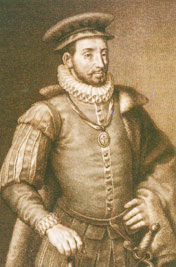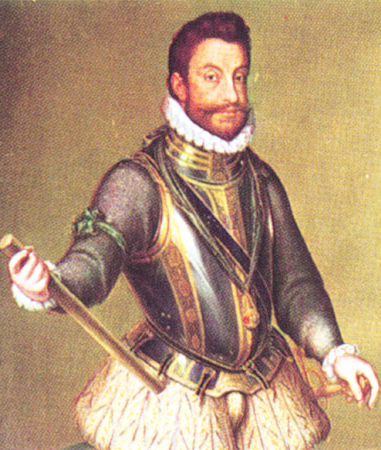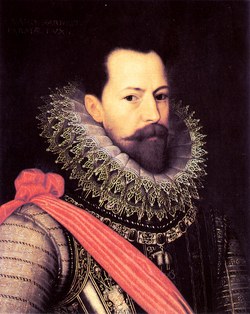
The 80 Years War Part II
A succession of Low Countries governors
Luis de Requesens, 1573-1576

Luis de Requesens was appointed as Flanders' of the Low Countries in 1573. After the first years of military campaigns and battles Spain was seeking to negotiate a way out of the war. He supressed the Council of Troubles and initiated peace talks with the more moderate sectors of the rebels in Breda.
Despite his more tolerant approach, he didn't achieve much. Not for lack of trying but rather because the Spanish King, Philip II wanted to return to status quo before the uprisings began. He did not budge on the point of religious freedom as the Spanish school of thought was pretty strict when it came to religion, nor did he grant autonomy to his regions, something the Dutch considered unacceptable. Luis de Requesen' hands were tied.
At the same time the waning economy made military victory practically impossible for the Spaniards, despite some achievements on this field, such as the Battle of Mookerheyde, where two of William of Orange's brothers were killed. The lack of payment gave way to mutinies in some troops, hindering Luis de Requesens' chance to take advantage of the situation.
Luis de Requesens sought a peace negotiation with William of Orange, and emperor Maximilian II acted as mediator. The Spanish governor declared that his troops would leave Flanders, so long as Catholicism was the only religion. But Protestantism in the form of Calvinism was too deeply rooted in the country, and the Dutch rejected Luis de Requesens' proposal. All military operations were halted for a year. Requesens died suddenly in Brussels.
John of Austria, 1576 -1578

Phillip II, who was still of a mind to find a conciliatory resolution to the war in the Low Countries appointed his step-brother, John of Austria. As soon as he arrived the Sack of Antwerp was carried out by mutinous Spanish troops. This violent pillage enraged the Dutch and joint all of the provinces together in a common cause: kick the Spanish armies out, signing the Pacification of Ghent.
The Spanish course of action was to negotiate, and in 1577 John of Austria began discussing the terms of peace with the States-General of the Netherlands. Despite their alliance they proved to be rather divided. The General-States demanded that the Spanish crow treated with William of Orange and that the Spanish troops leave their territory immediately.
On his part, John claimed his recognition as Governor of the Low Countries and restoration of Catholicism as the offiicial religion. The terms were accepted and John of Austria signed the Edict of 1577, in which he promised to remove the troops from the Low Countries within 20 days, abolish the Inquisition and recognized the Flemish autonomy as long as the sovereignty of the Spanish crown was acknowledged.
Despite the fact that the troops effectively moved to Italy, that measures of religious tolerance were taken and the political autonomy increased, William of Orange was proclaimed as Governor of Holland and Zeeland at the same time that the States-General recognized John of Austria as such, the rebel provinces maintained their position of adversaries of the Spanish monarchy.
The provinces where Protestantism was strongest didn't accept the return to Catholicism and calvinists offered the sovereignty of the Low Countries to Francis of Valois, while Brabant accepted William of Orange as their political leader. On the other hand the Catholic provinces offered the Low Countries' sovereignty to Matthias of Hapsburg, brother of Rudolf II, Holy Roman Emperor. The States-General appointed him as governor in 1577.
After all this happened, John of Austria took refuge in Namur and called the troops back. His forces arrived, commanded by Alessandro Farnese, Third Duke of Parma by the end of 1577. The rebels were forced to remove themselves from Antwerp and Brussels. The imperial and rebel troops confronted again it the beginning of 1578, in the Battle of Gembloux, destroying the rebel forces almost entirely. John of Austria died of typhus in October, 1578, after naming Alessandro Farnese as governor of the Low Countries.
Alessandro Farnese

While most of the Low Countries were controlled by the rebels, the calvinists began hunting down Catholics, kiling clerics and imprisoning those Catholics that supported the king. The independence of the Low Countries was becoming synonymous with Calvinism, something Alessandro Farnese took advantage off.
The Catholic provinces of the South reconciled with the king as to get his protection against the religious intolerance of the Protestants. In 1579 Alessandro Farnese signed the Union of Arras with the provinces of Douai, Artois and Hainaut, in which they recongnised the king's authority. The rebel provinces signed a similar alliance called the Union of Utrecht, by which they rejected any foreign country meddling in their affairs.
In 1581 Philip declared William of Orange and outlaw and offered a ransom for his head. William abjured his obedience to the king, publicly criticising his sovereign. It was a great achievement on his part that he got the the State-Generals to do the same in The Hague.
Of course, the Spanish continued with campaigning for the recovery of the rebel provinces. Alessandro Farnese took over the city of Tournai (Belgium). In 1583 he reconquers Dunkirk and Nieuwpoort, the most important ports of the Flemish coast. In 1584 he takes Bruges and Ghent. In the same year the Duke of Anjou died and William of Orange was murdered.
Alessandro Fernesio took advantage of the situation and besieged Antwerp. The blockade kept the whole continent in suspense, waiting to see who would be victorious. The siege meant a waste of resources and money. It lasted 13 months and in the end the richest and most populated city in Europe surrendered. It showed just how much the Spanish crown wanted its lost territories back.
If you want to continue reading about the 80 Years War, go to Part III or Part I if you want to know what happened before
.